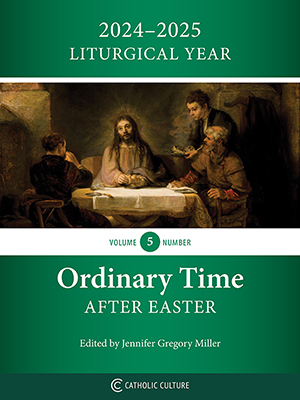What the rededication of Notre Dame (should have) taught us
By Phil Lawler ( bio - articles - email ) | Dec 17, 2024
The reopening of Notre Dame in Paris was a magnificent moment: a triumph of the human spirit, a moving moment for viewers all around the world, an event that drew attention to the glories of the Catholic tradition. Yet unfortunately, on a day that should have showcased the best of that tradition, the actual ceremony exposed the poverty of contemporary liturgical arts.
Name a modern building that would be mourned, as the world mourned in 2019, thinking that Notre Dame had been destroyed by fire. Name a church built in the past century whose restoration would be the cause of similar worldwide rejoicing. There is none; nothing even close. We cannot produce today the breathtaking works of art that Christian craftsmen fashioned centuries ago, despite our vaunted technical abilities.
With the restoration of the venerable basilica, modern technology reached across the centuries to form a partnership with 12th-century architecture. Secular firms made common cause with religious sensibilities. Vindicating the argument that Henry Adams made about the Virgin and the Dynamo, the people of Paris were drawn together once again by the campaign to recreate this building honoring Our Lady. The French populace tacitly understood the crucial importance of preserving and restoring their masterpiece, and— to our immense relief— insisted that the basilica should be rebuilt just as it had been. The faith may have lost its hold on the French people, but the artistic heritage has not; the churches may be empty, but the country is still proud of its Catholic heritage.
Giving glory to God
Why did the masons and craftsmen of nearly a millennium ago devote their entire lives to the creation of Notre Dame? Because they were inspired by the faith— and more precisely, by devotion to the Virgin. Their faith drove them to do what faith always does.
In text one of his many memorable sermons, St. John Henry Newman explained that drive of the faith in an arresting way, giving an unexpected answer to his own question about “what is the real final object of the Gospel Revelation”:
Men are accustomed to say, that it is the salvation of the world, which it certainly is not... Rather, as far as we are told at all, that object is the glory of God…
If the purpose of worship is to give glory to God, then in one sense our liturgical efforts and arts are never good enough. Still when we look at Notre Dame (or better, when we visit the basilica), we take justifiable pride in the attempt. This building, we can confidently say, represents the best of our efforts to glorify God. (And I say “we” can take pride because the builders of Notre Dame were our relatives, members of our family of faith.)
Yet on the day when the cathedral was rededicated, and the attention of the world was focused on this building that speaks of the hunger for transcendence, the ceremony failed to capitalize on this unique “teachable moment.” When the secular world paused, listening to hear the echoes of an ancient faith, the ceremony spoke only in modern language.
So inside this magnificent structure, whose stones move the visitor’s eyes toward heaven, the archbishop stood at a squat, unadorned, brutally geometric altar, built in a style utterly alien to the cathedral. When he commanded the organ to “speak,” that tremendous instrument produced a few rich notes, then a jarring jumble of discordant sound. On an occasion that should have underlined the continuity of our worship across the centuries, the clergy wore silly vestments, inspired by the most evanescent strands of pop culture. The liturgical gestures of the ceremony were complex, carefully choreographed, but somehow banal.
After the fact, people talked about the building, of course, and the remarkable success of the restoration. They talked about the celebrities who had attended the event, with Presidents Macron and Trump sitting side by side. They talked about the steeple and the bells and the stained glass. Nobody talked about the liturgy.
In many ways the rededication seemed a day of celebration for France rather than for Catholicism. Pope Francis was not present for his singular day; he had scheduled a consistory in Rome on the same weekend, although the date for the reopening ceremony had been set months earlier. He did, however, text send a message for the occasion:
May the rebirth of this admirable church be a prophetic sign of the renewal of the Church in France. I invite all the baptized who will joyfully enter this Cathedral to feel a legitimate sense of pride, and to reclaim their faith heritage.
Yes, but did the ceremony in Paris send that same message, calling the people of France (and of the world) to reclaim their Catholic heritage? Did it spark new signs of revival? Can the faith be restored, as well as the building that it inspired?
Sad to say, while Notre Dame has been restored to its former glory, other less prominent churches in France are being closed— or worse, vandalized and torched— every week. Having cheered the reopening of their most famous cathedral, the people of France went quickly back to ordinary daily life in a secular society, a crumbing culture.
Yes, the faith can be restored, just as the building was restored. But first we need a sober appraisal of where we stand: of the damage that has been done. Then we need the same inspiration that fired the imagination of the original architects and fueled the dedication of the tireless masons and carpenters. We need to revive the understanding that our goal is not to demonstrate our technical prowess, nor to satisfy popular tastes, but to give glory to God.
All comments are moderated. To lighten our editing burden, only current donors are allowed to Sound Off. If you are a current donor, log in to see the comment form; otherwise please support our work, and Sound Off!
-
Posted by: ewaughok -
Dec. 18, 2024 8:51 PM ET USA
Thanks, Mr. Lawler for an incisive commentary on the Notre Dame Cathedral opening ceremony. You end specifying three needs: for a honest appraisal, for the same inspiration, and for a revived faithful Catholic understanding. But a need must be felt not posited intellectually. Most people don’t feel this way anymore about the Christian faith. Such needs are not felt. Pope Benedict XVI was right that the church in the future will be smaller, but more faithful and fervent. But definitely smaller!
-
Posted by: Lucius49 -
Dec. 17, 2024 10:54 PM ET USA
The vestments used in ND as you noted were ugly and not worthy of the liturgy. The altar looks like a bowl with a bare lecturn in the sancturay trophies of spiritual decay contradicting the Catholicity and beauty of Notre Dame. The Archbishop of Paris perhaps consulted with the Archbishop of Berlin who has turned St. Hedwig’s into an auditorium with the same bowl “altar” more signs of the grave crisis in the Church” the false, the bad, the ugly.








